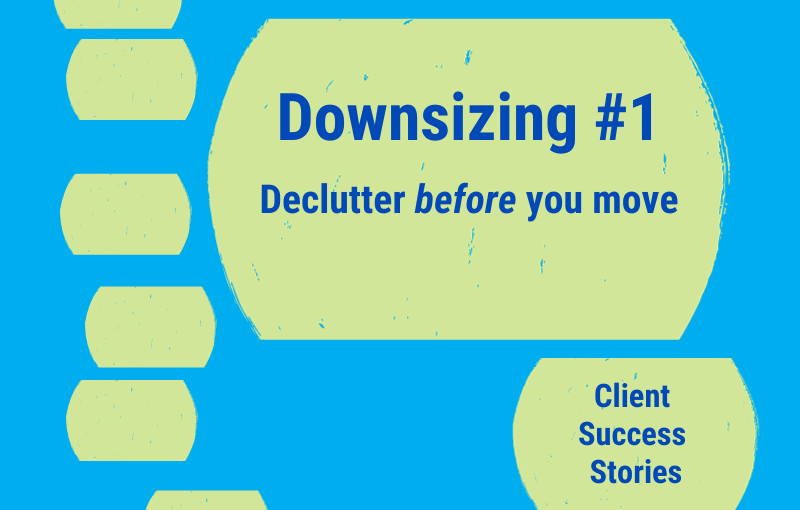Downsizing – moving from a bigger to a smaller place – is a huge life transition.
That’s why you need time – and courage – to prepare the move carefully.
CLIENT STORY
When Ellen called me, she was desperate.
In fact, I got quite confused and even worried during the first 3 to 5 minutes of our phone conversation – Ellen was crying so heavily that she couldn’t talk.
She then managed to calm down, and she introduced herself and described her problem:
It was her removal day: that morning she had moved out of her 3-bedroom-house into her new home, a 1-bedroom-apartment in a retirement village.
The removalists had just left her, in the middle of a ‘terrible chaos’ as she said. As she continued to explain her situation I started to understand her distress, and I agreed to meet her at her new place 2 hours later.
Ellen waited at the entrance gate of the retirement village when I arrived at the address she had given to me. She was still very upset, she said she feared she had made a huge mistake, and that she didn’t know what to do, and that she felt help- and hopeless. She started crying again.
When we entered her new apartment, I took a deep breath.
It was so full! It was understandable that Ellen felt like being in the wrong place!
The apartment was so fully packed with furniture and removal boxes that it was difficult to walk inside and around.
There were no empty surfaces and all around stuff was stacked up to the ceiling. Even the bathroom was not usable, cluttered with containers and lose items. The bedroom and the kitchen – the same.
We couldn’t sit anywhere and finally walked outside and sat down on a bench in front of the building. I have to admit that I felt very angry with the removalists who had left Ellen – alone – in such a mess. However, it was not their fault, of course.
The cause of the problem was that Ellen hadn’t been able to let go of any of her personal belongings, she had hoped that they ‘somehow’ would fit into the build-in wardrobes, and into the storage area that belonged to the apartment.
Yes, she had sorted out a lot before the move, particularly several pieces of furniture, such as the large dinner table, some chairs and arm chairs, the huge desk, some bigger paintings, and the outdoor furniture.
However, she had kept everything else, everything that had been stored inside the discarded furniture and built-in cupboards. And had now ended up with all these belongings in a place that had to offer just one quarter of the space that she had had before.
The underlying reason for this seemingly ‘irrational’ behaviour was that Ellen had been so afraid and anxious about the big changes coming up with the move – the new place, the new neighbours, the new life – that she had kept all her belongings as a kind of ‘safety net’. She had thought she would feel o.k. if she had all the things around her that had been with her in the old life.
Also, she didn’t have any plan or idea of what her new life would look like, thus she felt unable to decide what she might no longer need.
It was late in the afternoon, and we couldn’t do much on that day, but we created an ‘emergency plan’ to help Ellen through the near future and to finally get her problem sorted out.
I didn’t have a client appointment the next day which was followed by a weekend, thus we had 3 days to create a temporary solution – an apartment that was sufficiently cleared up and safe to live in.
These were our short term actions:
- Ellen called a friend who offered her a bed for the next 2 to 3 nights.
- We talked with the retirement village manager and Ellen was able to rent 2 additional parking spaces in the garage for the next 2 to 3 months.
- We made a list of all belongings that Ellen needed to manage her daily life during the next weeks: all the furniture and things required in the kitchen to prepare her meals, all the personal belongings she needed in the bathroom and in the bedroom, the furniture she wanted to place in the living room.
- We carried all furniture and other lose/bigger items that were not on the list downstairs, and stored them in Ellen’s 3 parking spots in the garage.
- We cleared the kitchen table to get a free surface for our unpacking and sorting activities.
- We opened every removal box and took out only what was related to our list of needed items.
- We started an inventory and kept notes about all boxes with currently not needed content before we stored those boxes in the garage.
- We organised all the things which were to be kept in the apartment in the available build-in wardrobes, cupboards and shelves.
On the first morning of our 3 working days, I was a bit worried about how Ellen would cope. But she actually managed very well.
I assume it helped her to know that all the belongings leaving the apartment didn’t disappear forever, that they just moved downstairs into the garage.
Ellen also said that it felt good to get active and to do something, she felt no longer so desperate and more in control.
At the end of the 3 days, Ellen could finally move into her now clear and spacious apartment. She had all she needed for her daily life easily accessible and close to her, and anything else safely stored in boxes in the garage.
I had arrangements with other clients for the next 2 weeks, and Ellen decided to use the time to get to know her new living area and her neighbours.
She also agreed to keep a journal and to think about what was really important to her and how she wanted to live now, in this not only new place but also new phase of her life.
She also decided to take notes in her journal whenever she missed anything of the stored away stuff.
When we met again 2 weeks later, … (This is the first in a series of 3 posts – Click here to read post No 2)

